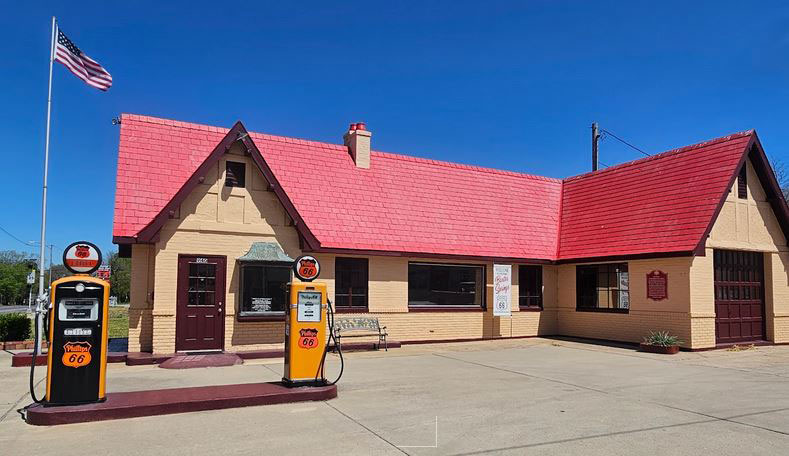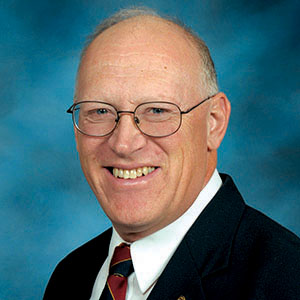
Route 66 Visitor's Center in Baxter Springs | Download this photo
Kansas Profile – Now That’s Rural: Mary Billington, Route 66 Visitors Center
At a glance: The Route 66 Visitor’s Center in Baxter Springs shares the story of historic Route 66 with visitors from across the nation and beyond. The community also helped provide inspiration for elements of the animated movie, Cars, which has also sparked interest in the region.
More information: Ron Wilson, rwilson@ksu.edu, 785-532-7690
Photos: Ron Wilson | Route 66 Visitor's Center
Website: Huck Boyd National Institute for Rural Development
March 20, 2024

By Ron Wilson, director of the Huck Boyd National Institute for Rural Development at Kansas State University
“Get your kicks on Route 66.”
In the 1940s, that was a line from a popular song that described people’s fascination with the famous highway to the southwest. Today, we’ll learn more about a Kansas community on this historic route that is sharing its legacy.
Last week, we met Mary Billington, director of the Baxter Springs Heritage Center and Museum and the Route 66 Visitor’s Center in Baxter Springs. Among its other historic distinctions, Baxter Springs is located near the fabled highway known as Route 66.
The Baxter Springs Heritage Center and Museum highlights the rich history of the region. Nearby is the Route 66 Visitor’s Center.
The visitor’s center was originally constructed as a gas station in 1930. In 2005 it was purchased by the historical society, remodeled to become the visitor’s center and restored to its 1940s appearance in 2007.
The building is called the Route 66 Visitor’s Center because of Baxter Springs’ location on the historic highway. Route 66 went from Chicago south and west through Missouri, across the corner of Kansas and then west to California. It received its federal highway Route 66 designation in 1926. It served as a major thoroughfare for travelers and those migrating west for a better life after the Dust Bowl, for example.
“There was so much pain, misery and joy tied to this road,” Billington said. In the book The Grapes of Wrath, John Steinbeck termed it the Mother Road when describing the route followed by desperate, dispossessed workers going west.
Not all was doom and gloom. In 1946, there was a hit song titled “(Get Your Kicks on) Route 66,” followed by a popular television show of the same name.
The advent of the interstate highway system rendered the old two-lane highway unnecessary. In 1985, the mother road was decommissioned, but memories of its significance still run strong.
A national centennial commission for Route 66 is planning events for 2026. In anticipation of the centennial of Route 66’s creation, bipartisan legislation has been introduced in Congress to designate Route 66 as a national historic trail.
The original Route 66 covered 2,448 miles. Only a handful of those are in Kansas, but Kansas has made the most of those few miles. The State of Kansas designated a Route 66 Scenic Byway from the Missouri line to the Oklahoma border. The byway originates in Galena and ends in Baxter Springs.
In between, it passes through the rural community of Riverton which, with the nearby area, is estimated to have a population of 771 people. Now, that’s rural.
The 2006 animated movie, Cars, sparked a resurgence of interest in Route 66 and had several Kansas connections. That movie features talking cars that travel along Route 66 and deal with challenges in the semi-abandoned town of Radiator Springs.
In a case of art imitating life, the town of Radiator Springs is struggling after being bypassed by the interstate, mirroring the real world experience of small communities along the route. Some say Galena was the inspiration for the fictional town of Radiator Springs.
The Cars movie is peopled with memorable characters. My personal favorite is Tow Mater, the countryfied tow truck voiced by Larry the Cable Guy and known as Mater for short. Fittingly for a tow truck, one of Mater’s skills is an ability to accurately drive backward.
According to one source, Mater’s design is supposedly based on an actual Chevy tow truck once used to lift equipment from mine shafts in Cherokee County, Kansas. The ability to drive backward was supposedly inspired by “Crazy Legs Walker,” a Riverton resident and Kansas Route 66 Association member who is known for his ability to turn his feet backward.
Thus it is fitting that the visitors center in Baxter Springs is known as the Route 66 Visitor’s Center. For more information, see http://www.baxterspringsmuseum.org/
You can still get your kicks on Route 66 in Baxter Springs, Kansas. We commend Mary Billington and those involved with the visitor’s center for making a difference through tourism and customer service.
I get a real kick out of it.
Audio and text files of Kansas Profiles are available at http://www.kansasprofile.com. For more information about the Huck Boyd Institute, interested persons can visit http://www.huckboydinstitute.org.
***

K‑State Research and Extension is a short name for the Kansas State University Agricultural Experiment Station and Cooperative Extension Service, a program designed to generate and distribute useful knowledge for the well‑being of Kansans. Supported by county, state, federal and private funds, the program has county extension offices, experiment fields, area extension offices and regional research centers statewide. Its headquarters is on the K‑State campus in Manhattan. For more information, visit www.ksre.ksu.edu. K-State Research and Extension is an equal opportunity provider and employer.